Isn't this one of the worst scenarios you could imagine yourself to be in? Don't panic; you're not the only one. Although dangerous ransomware attacks often happen on computers. Now, these attacks are going to damage your entire system, thereby making it difficult for you to access the files.
The good news, however, is you can encrypt ransomware virus files. Ransomware virus-encrypted file recovery can be done via different methods so that you're able to access your files again. Almost everyone is at risk of ransomware attacks as long as they're not mindful of security. This blog explains in detail all you need to know about ransomware virus encrypted files recovery.
Try Wondershare Recoverit to Perform Ransomware Encrypted File Recovery

In this article
Part 1: What Is a Ransomware Attack?
Ransomware attacks are one of the most common issues that most people face. This computer virus spreads via different methods, such as website pages, Trojans, email, and more. Ransomware attacks use an encryption algorithm that locks all your files. It is extremely dangerous for your system as you may not be able to recover once the files are locked.
Ransomware affects vulnerability, mail, and advertising. If the computer gets affected by any ransomware attack, it will be extremely difficult for you to access the infected files. Moreover, in order to gain access to the files, you will have to pay the ransom.
Part 2: Why can’t most ransomware encryption be cracked?
Ransomware is a type of crypto-virus that attacks the system, leading to all the files being locked. These use sophisticated algorithms, which makes it difficult to open the systems. The secret keys further lead to encryption and decrypting the keys.

Encryption is an efficient security tool that aims to protect all data. Most of the ransomware attacks use this technology as a weapon. Therefore, they affect the data and lead to the files being locked.
Part 3: Common Ways Your Files Get Encrypted or Locked
Ransomware attacks mostly happen when the system's security is very poor. You must analyze your system's data security policy to keep it safe as well and boost ransomware data recovery chances.
Some of the common ways your system can become victim to ransomware attacks and files get encrypted include the following:
1. Open Remote Desktop Protocol Ports (RDP)
Many people often lead to the remote desktop protocol ports opening, which paves the way for security systems to be hacked. Cybercriminals can easily infiltrate into the systems through these open ports. As soon as the hacker enters into the system, they can leave ransomware and malware in the system.
A lot of ransomware attackers use this method to enter through the backdoor and affect the system. This increases security vulnerability, thereby affecting the system. It is important to close the remote desktop protocol ports across all servers' endpoints.

2. Phishing attacks
Phishing attacks are one of the most common ransomware attacks. These can eventually lead to the files being locked or encrypted. In regards to phishing attacks, the hackers can enter the system through malicious links, file downloads, or emails.
These phishing emails contain malicious links which attract the attention of the recipient to click on them. Cybercriminals use social engineering, which often makes it individual to detect phishing attacks. It is extremely important to read the email details carefully before clicking on any link or downloading the files from it.
3. Compromised passwords
One must be very careful about the passwords they are using. Compromised or common passwords can be very dangerous, as hackers can easily gain access to the system. You must refrain from using the same password for multiple accounts.
Never use any outdated or overused passwords, especially to access your corporate data. There is a chance that cybercriminals can use these passwords to access your data, thereby increasing the risk of attacks and the demand for ransom. This can, therefore, have a negative impact on your system and lead to files being lost.
Part 4: What to Do After a Ransomware Attack?
Falling victim to a ransomware attack is nothing new to an individual or an organization. However, it can be deadly. Here are some of the things you must do after falling victim to a ransomware attack:
1. Disconnect the device: As soon as you detect that any malware has infected your system, disconnect the device immediately from the network and external storage. This is to prevent the other systems on your network infrastructure from getting infected. Furthermore, if the organization has been infected with the device, it is important to check how many systems were infected.
2. Identify the type of ransomware: It is important to check the type of ransomware that infected your device. For example, it can open a suspicious email or download any file. These files can attack your valuable information, exposing vulnerability and preventing data protection.

3. Report the issue: If you notice any suspicious activity on your system, it is important to report the problem immediately. You must report the ransomware attack to the authorities. It is also important to provide necessary information to the authorities to prevent future attacks.
4. Measure the impact: How many files were damaged due to the attack? In an organization, you must check how many systems were impacted. To understand the effect, it is also important to know how long it would take to fix the ransomware attack. Moreover, it is also important to assess the importance of data that has been made unavailable.
5. Recover the data: Now, the next step is to recover the data that were damaged due to encryption. You can adopt different methods to ransomware virus encrypted files recovery.
Part 5: How to Recover Ransomware Encrypted Files?
Ransomware can significantly encrypt all your files, making it difficult for you even to recover them. You may feel that all your files are lost. However, the good news is that you can recover ransomware-encrypted files via different methods.
Some of the prominent methods to ransomware virus encrypted files recovery are as follows:
Method 1: Use a Data Recovery Tool- Wondershare Recoverit
A ransomware recovery software is one of the most reliable choices for restoring ransomware encrypted files. Wondershare Recoverit is a smart choice to make. The tool will allow you to recover different types of files from your system. Therefore, it will be easier for you to recover the ransomware-encrypted files as well.
Wondershare Recoverit is available for free use for both Mac and Windows users. Once downloaded and installed into the system, Wondershare Recoverit will be ready to be used to recover ransomware-encrypted files.
Follow the steps below to ransomware virus encrypted files recovery using Wondershare Recoverit:
Step 1: Launch Wondershare Recoverit in your system and click the disk or hard drive from which you want to recover the files. The hard drive options are available under the Hard Drive and Location option.
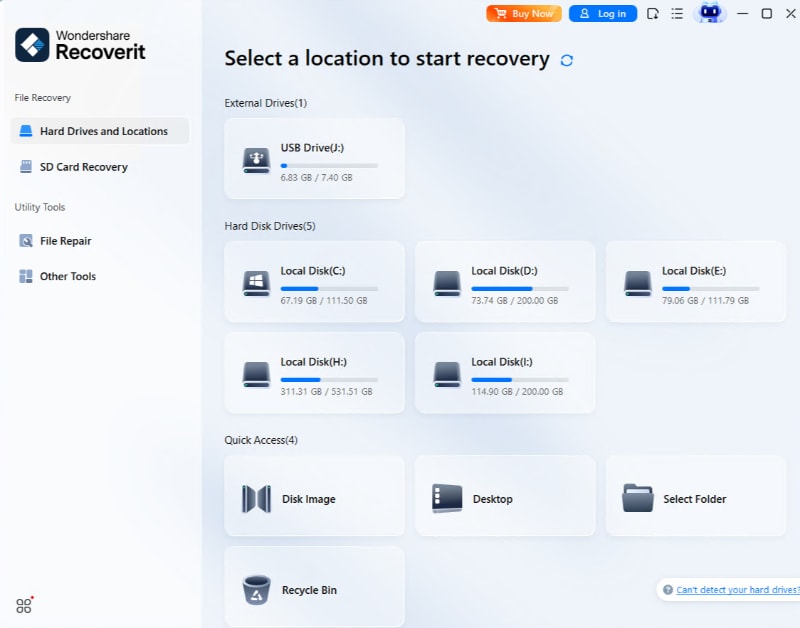
Step 2: The app will begin scanning the selected hard drive or disk.
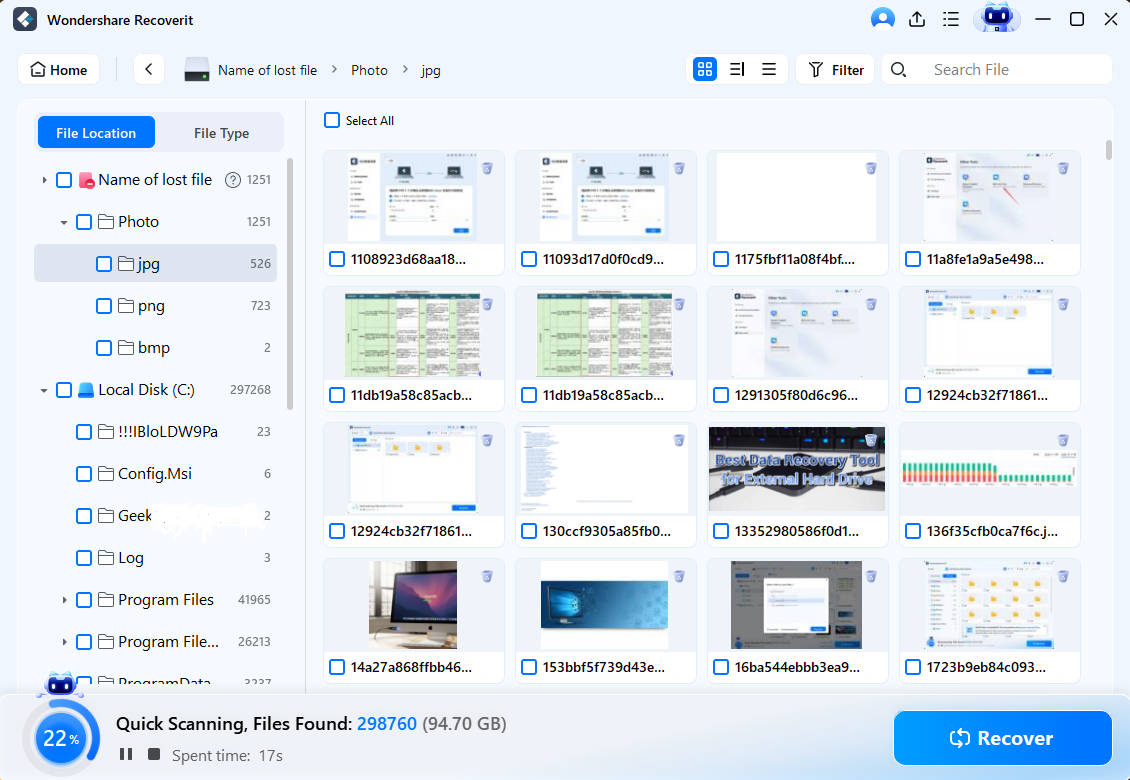
Step 3: Once the scanning is completed, you can apply specific filters available on the top of the menu bar to make it easier for you to find the files.
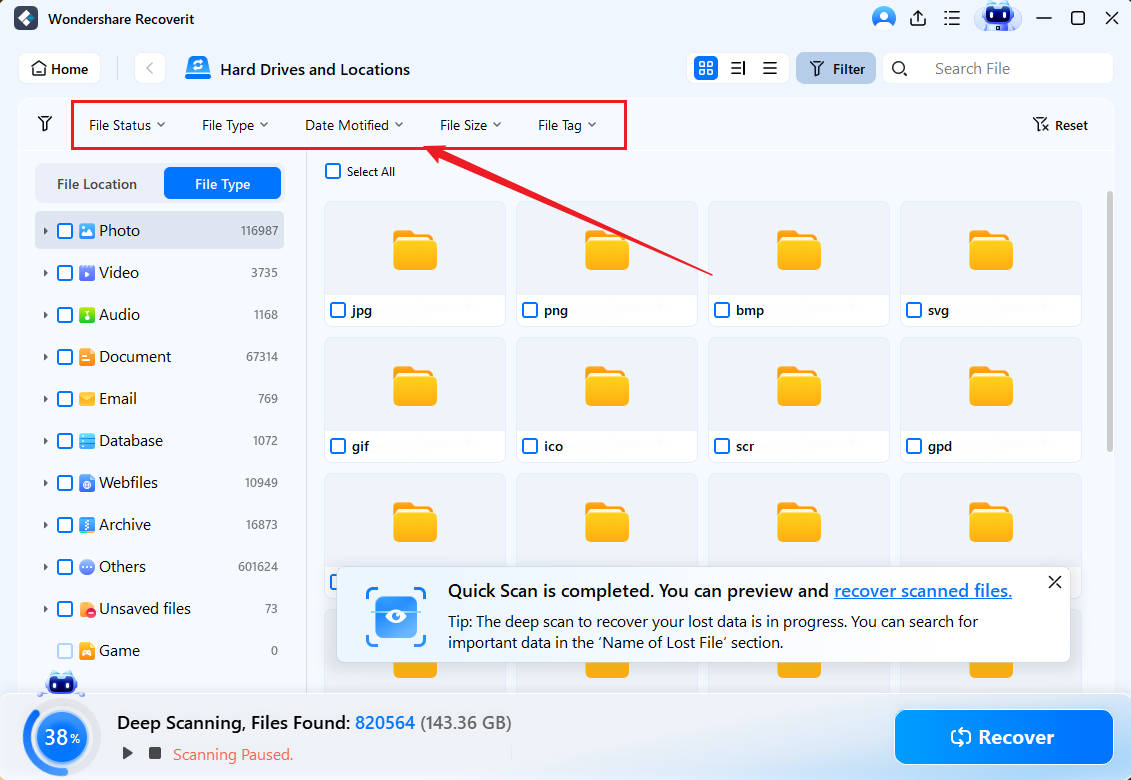
Step 4: If you want the specific file to appear immediately, enter the keyword in the search box and press enter. The file must appear on the screen.
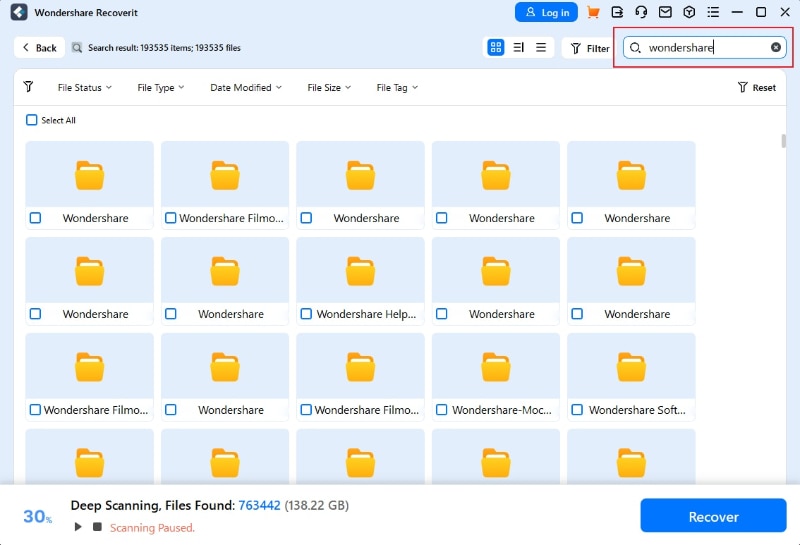
Step 5: The app lets you get a preview of the recovered files. You can hit the preview button and check all the files, and if they have been recovered properly, click on the Recover button for that file.

Step 6: Select the location where you want to save the files. Make sure that it is a new drive or location where the files are being saved to avoid further corruption.
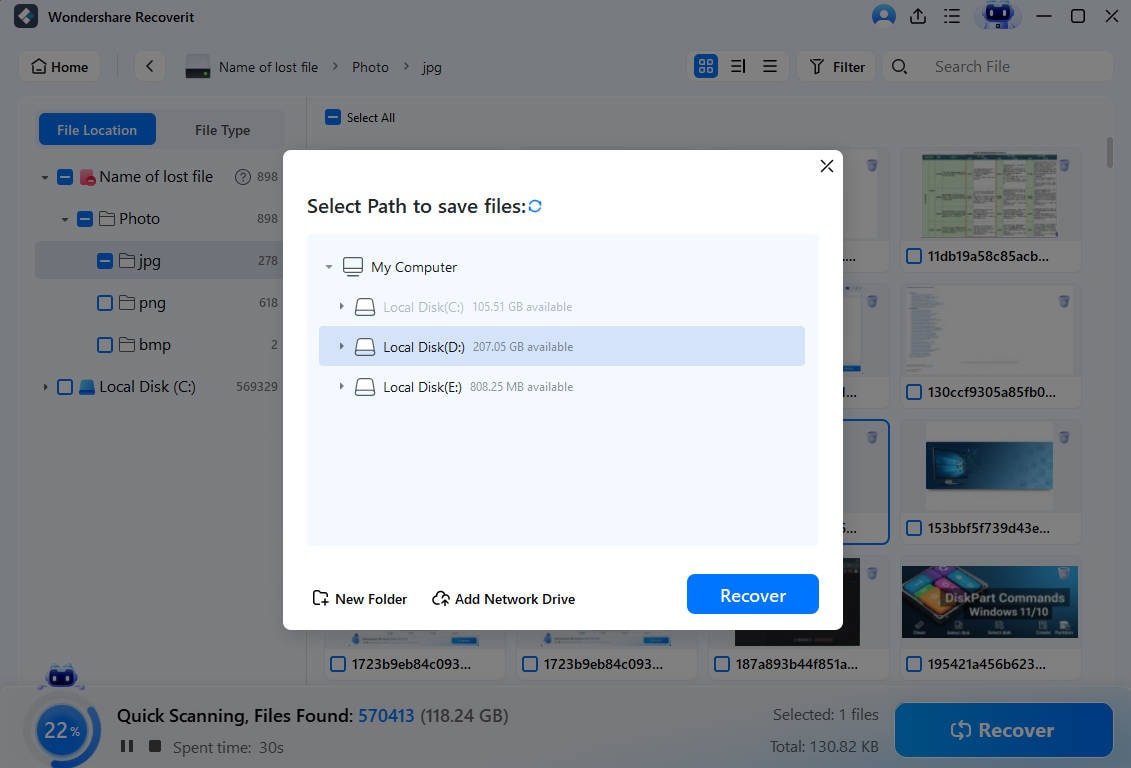
The files will appear on your screen after some time, depending on the size of your file.
Method 2: Restore from System Backup
The system backup functionality to recover ransomware encrypted files will only work when you have taken a backup of the files. It is advisable to turn on the automatic backup feature of Windows systems so that all the files are backed up. As a result, if required, you can recover the files in the future.
Follow the steps given below to restore the files using system backup to learn how to recover ransomware encrypted files:
Step 1: In the search bar type Control Panel and open it.

Step 2: On the left side, click on System and Security option.

Step 3: Under the Backup and Restore option, choose Restore files from the Backup option.

Step 4: In the new screen, hit Restore My Files. Follow the on-screen instructions and the files will be restored to your system.

Method 3: Restore from Previous Versions
If you have had any previous version of the file, it can be equally helpful for recovering ransomware encrypted files. You need to follow the steps given below to restore files from the previous version for ransomware virus encrypted files recovery:
Step 1: Open This PC on your system and select the directory where the file is located. Right-click on the file and choose the Properties option.

Step 2: Under the Properties option, click on the Previous Versions tab.

Step 3: All the options for the previous versions of the file will appear on the screen. Click on the ones that are the most appropriate.
Step 4: Now, click on the View option and check if the correct version of the file is available. After finding the right version, you can do any of the following:
- View: View the file and click on File> Save As to save the file.
- Copy: Create a copy of the previous version in the same directory. Both versions will be available in the system.
- Restore: Restore the file in your system, which will replace the existing version.

Method 4: Recreate the Data
Recreating the data from the source can be extremely beneficial in terms of recovering the data. It will allow you to get all the information so that you won't have to struggle much.

Here are some of the key ways through which you can recreate the data for decrypting the files and understand how to recover encrypted files from ransomware:
- Recreate from hard copy: If you have any hard copy of the data, you can manually enter the data into your computer and create a soft copy of it.
- Save from email: If you have mailed the files to anyone, you can just download them from your email.
- Database mining: Ransomware often damages only a small part of the file. Therefore, you can opt for database mining to recreate and save the files.
Method 5: Run Antivirus and Security Software
A lot of computers can get attacked by ransomware. This can damage your system and often lead to it being unlocked. Therefore, it is advisable to run an antivirus and security software to recover files from ransomware.

You will have to download a reliable antivirus and security software into your system to protect your device. The software will not only protect your files but also help in recovering them in case anything goes wrong.
Part 6: How to Prevent Ransomware File Encryption in the Future?
Ransomware attacks are common and can happen anytime. However, if you take proper prevention methods, it will be easier for you to avoid the risk of ransomware attacks in the future.
Some of the common prevention strategies for prevention and ransomware data recovery that you must integrate are as follows:
- Always use antivirus software on your computer and keep them updated.
- Never download any file or click on any link from a suspicious-looking email.
- Always back up your data to prevent the risk of completely losing the file in case of any malware attack or infection.
- Make yourself aware of security vulnerabilities to prevent the risk of future attacks.
- Never open emails that may be sent to you from unknown senders.
- Always report the ransomware attack as soon as you notice anything that is completely illegal.
Conclusion
A ransomware attack is one of the biggest threats that you can ever face in your system. It is extremely important to be mindful of emails, attachments, files, torrents, or any third-party websites. One small opening can also be effective for the attackers to get into your system and corrupt your files.
However, know that the files aren't completely lost. You still have the option for ransomware virus encrypted files recovery using different methods such as a data recovery tool, system restore, system backup, and more. Follow the steps to recover the encrypted files properly so that you won't have to struggle with recovery. As for the rest, keep yourself and your system updated to avoid the risk of attacks.
FAQs
1. Can we decrypt ransomware encrypted files?
Yes, you decrypt ransomware encrypted files. There are different methods through which you can do this, such as using a data recovery tool or restoring from the previous versions.2. How long does it take to decrypt ransomware?
The time taken to decrypt ransomware files can vary significantly depending on different factors. On average, it must take up to 22 days for the files to be decrypted properly.3. How to recover encrypted files?
You can use a data recovery tool such as Wondershare Recoverit to remove the encrypted files.




 ChatGPT
ChatGPT
 Perplexity
Perplexity
 Google AI Mode
Google AI Mode
 Grok
Grok























